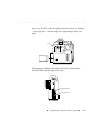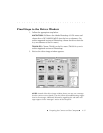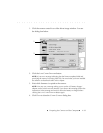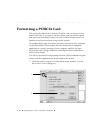
. . . . . . . . . . . . . . . . . . . . . . . . . . . . .
4-36 Preparing the Camera and the Computer
provides one example using the KODAK Driver with Adobe Photoshop.
If you use other supported software, refer to its documentation to deter-
mine if it is TWAIN-compliant, and if it is, how it provides access to
TWAIN drivers.
As you use a variety of TWAIN-compliant software, it may be helpful to
know how the TWAIN specifications expect applications to perform. The
specifications provide for a consistent software interface by encouraging
software developers to include two specific commands — S
ELECT SOURCE
and ACQUIRE — on the FILE menu. The specification intends that users
should first choose S
ELECT SOURCE which should display a list of TWAIN-
compliant device drivers installed on the system. After the user selects a
driver from the list, he/she should be returned to the application. The user
should then choose ACQUIRE which should open access to the device and
allow the user to obtain image data.
IMPORTANT: Some image editing software takes all available RAM by default at
start-up. The TWAIN driver will not work if this occurs. To avoid the problem, set
the memory preference for your application (often found on the F
ILE menu) so that
there is at least one megabyte of free RAM.
Once you have installed the TWAIN driver as described earlier in this
chapter, and are running Photoshop, you access the driver by following
these steps.
1. Choose SELECT TWAIN SOURCE on the IMPORT submenu on the Adobe
Photoshop F
ILE menu; the SELECT SOURCE dialog box appears. (For
earlier supported versions of Photoshop choose S
ELECT TWAIN SOURCE
on the ACQUIRE submenu on the Adobe Photoshop FILE menu.)
2. Click the name of the camera driver.
3. Click S
ELECT; you are returned to Photoshop.
NOTE: The choice is maintained in a preference file for the TWAIN-compli-
ant driver; you do not need to repeat steps 1 through 3 each time you use the
driver.


















